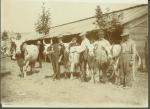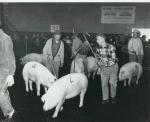![header=[Marker Text] body=[One of Pennsylvania's three original counties, formed 1682 by William Penn. Name derived from Cheshire in England. West Chester, the county seat since 1788, was incorporated in 1799. County was the scene of important military activities in 1777-1778.] sign](http://explorepahistory.com/kora/files/1/10/1-A-1D9-139-ExplorePAHistory-a0b9b0-a_450.gif)
Mouse over for marker text
Name:
Chester County (Chester White)
Region:
Philadelphia and its Countryside/Lehigh Valley
County:
Chester
Marker Location:
County Courthouse, North High Street, West Chester
Dedication Date:
October 26, 1982
Behind the Marker
When Europeans traveled to the Americas, they brought with them their own grains and domesticated animals. Early Pennsylvania farms had cows, sheep, goats, horses, and pigs, the last of which were well suited for the colony. Where cows and other livestock ideally required pasture and milking, pigs simply could be released to fend for themselves. These feral pigs, or "wood hogs," could be captured or hunted for food. In addition, in days before refrigeration, salted pork kept better than other meats.
The "low-carb" and low-fat diets of today probably would make our founding fathers and mothers roar with laughter. They were used to eating much heartier fare. In the United States, from colonial times through the mid-1900s, some form of salted and/or smoked pork (bacon, ham, sausages, salt pork, and "pickled pork") was a regular feature of just about any meal, and lard was the cooking fat and shortening of choice.
Pigs were easy to keep and could survive - in fact thrive - with minimal care. They could forage for food themselves, they reproduced in abundance, and they grew and reached maturity quickly. But pigs are not native to the Americas; Europeans brought them here. Columbus brought the first swine to islands in the Caribbean in 1493 and Spanish explorers and settlers who followed after him arrived with many more. The first pigs in the Delaware Valley came in the early 1600s with Dutch and Swedish settlers. English colonists to Pennsylvania brought the more significant numbers of swine with them. Descendants of these hogs became the foundation of an important new breed that got its start on the Jefferis farm in Chester County, Pennsylvania.
Born in 1759, James Jefferis (d. 1822) grew up on his father's "plantation" at the Forks of the Brandywine. Rather than stay on the farm, he took up seafaring and eventually became the captain of the ship Neptune, which sailed out of Wilmington, Delaware to the West Indies, Europe, and India. Jefferis sailed the seas for about thirty years before retiring to the family farm upon which he was born. There he established himself as an industrious and skillful businessman and agriculturalist. Director of West Chester's bank, Jefferis, like some other businessmen-farmers, became interested in improving the quality of his pigs, and those of the farmers in the rest of the state and the nation through careful breeding with better stock.
In much of the eighteenth century, most Pennsylvania farm pigs were still half-wild creatures that spent most of their lives in the woods foraging on acorns and beechnuts and anything else they could eat. But the woods were fast disappearing and free-ranging swine often made their way to other farmers' gardens where they gorged themselves and rooted up fields. Penning livestock was fast becoming the preferred method of animal husbandry. Feral pigs were neither very docile nor very big - when caught and slaughtered they didn't weigh much more than 180 pounds and generally their meat was lean and tough. Captain Jefferis was interested in breeding a tamer hog that put on weight quickly.
Sometime around 1815, Jefferis imported a white-skinned Bedfordshire or Cumberland boar from England, which he bred to white sows on his farm. Soon he was selling the resulting offspring and offering his boar for stud services to other farmers in the area. In this way, pigs in the region were gradually transformed from the aggressive, lanky, half-wild, razor-back wood hogs into a docile porker that put on great amounts of weight when fed a diet of fruit, grain, vegetables, and "slops" in pens.
The "Chester White," as Jefferis' new breed soon became known, also was much more prolific and a better mother than the nondescript pigs. A mature Chester White could weigh from 300 to 500 pounds and for farmers that meant a lot of meat and lard for the family cellar and markets at home and abroad.
In the nineteenth and twentieth centuries, many farmers in the United States preferred the Chester White to other breeds because of its docility and ability to gain weight for market. Other hog farmers made further improvements in the breed, which resulted in the development of additional strains known as the "Improved Chester White" and the "Ohio Chester White." And in the second half of the twentieth century, the pig that Captain James Jefferis first bred on his farm near West Chester, Pennsylvania changed yet again.
As lard fell out of favor as the cooking fat of choice, breeders have made the pig leaner than its ancestors of a century ago. Today, the Chester White remains one of the six major hog breeds in the United States.
The "low-carb" and low-fat diets of today probably would make our founding fathers and mothers roar with laughter. They were used to eating much heartier fare. In the United States, from colonial times through the mid-1900s, some form of salted and/or smoked pork (bacon, ham, sausages, salt pork, and "pickled pork") was a regular feature of just about any meal, and lard was the cooking fat and shortening of choice.
Pigs were easy to keep and could survive - in fact thrive - with minimal care. They could forage for food themselves, they reproduced in abundance, and they grew and reached maturity quickly. But pigs are not native to the Americas; Europeans brought them here. Columbus brought the first swine to islands in the Caribbean in 1493 and Spanish explorers and settlers who followed after him arrived with many more. The first pigs in the Delaware Valley came in the early 1600s with Dutch and Swedish settlers. English colonists to Pennsylvania brought the more significant numbers of swine with them. Descendants of these hogs became the foundation of an important new breed that got its start on the Jefferis farm in Chester County, Pennsylvania.
Born in 1759, James Jefferis (d. 1822) grew up on his father's "plantation" at the Forks of the Brandywine. Rather than stay on the farm, he took up seafaring and eventually became the captain of the ship Neptune, which sailed out of Wilmington, Delaware to the West Indies, Europe, and India. Jefferis sailed the seas for about thirty years before retiring to the family farm upon which he was born. There he established himself as an industrious and skillful businessman and agriculturalist. Director of West Chester's bank, Jefferis, like some other businessmen-farmers, became interested in improving the quality of his pigs, and those of the farmers in the rest of the state and the nation through careful breeding with better stock.
In much of the eighteenth century, most Pennsylvania farm pigs were still half-wild creatures that spent most of their lives in the woods foraging on acorns and beechnuts and anything else they could eat. But the woods were fast disappearing and free-ranging swine often made their way to other farmers' gardens where they gorged themselves and rooted up fields. Penning livestock was fast becoming the preferred method of animal husbandry. Feral pigs were neither very docile nor very big - when caught and slaughtered they didn't weigh much more than 180 pounds and generally their meat was lean and tough. Captain Jefferis was interested in breeding a tamer hog that put on weight quickly.
Sometime around 1815, Jefferis imported a white-skinned Bedfordshire or Cumberland boar from England, which he bred to white sows on his farm. Soon he was selling the resulting offspring and offering his boar for stud services to other farmers in the area. In this way, pigs in the region were gradually transformed from the aggressive, lanky, half-wild, razor-back wood hogs into a docile porker that put on great amounts of weight when fed a diet of fruit, grain, vegetables, and "slops" in pens.
The "Chester White," as Jefferis' new breed soon became known, also was much more prolific and a better mother than the nondescript pigs. A mature Chester White could weigh from 300 to 500 pounds and for farmers that meant a lot of meat and lard for the family cellar and markets at home and abroad.
In the nineteenth and twentieth centuries, many farmers in the United States preferred the Chester White to other breeds because of its docility and ability to gain weight for market. Other hog farmers made further improvements in the breed, which resulted in the development of additional strains known as the "Improved Chester White" and the "Ohio Chester White." And in the second half of the twentieth century, the pig that Captain James Jefferis first bred on his farm near West Chester, Pennsylvania changed yet again.
As lard fell out of favor as the cooking fat of choice, breeders have made the pig leaner than its ancestors of a century ago. Today, the Chester White remains one of the six major hog breeds in the United States.








